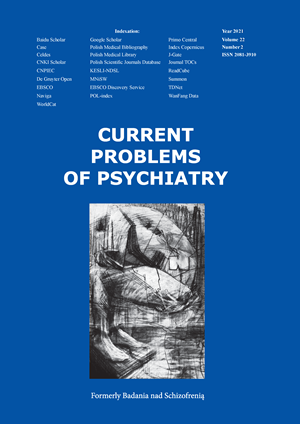Susac syndrome with cognitive impairment – case report of 31-year-old woman
DOI:
https://doi.org/10.2478/cpp-2021-0007Keywords:
Susac's syndrome, cognitive impairment, hearing loss, visual disturbances encephalopathyAbstract
Introduction: Susac syndrome (SuS) is a rare immune-mediated disease caused by occlusions of microvessels in the brain, retina and inner ear. It is characterized by the clinical triad of encephalopathy, visual disturbances and hearing loss. The diagnosis of SuS is based mainly on the clinical symptoms and the supporting tests in which characteristic changes occur in the MRI.
Case report: Here, we present a case of a patient with possible SuS with psychiatric symptoms. A 31-year-old woman was admitted to the Department of Psychiatry due to deteriorating mental health for several weeks manifested as a negative mood and suicidal thoughts. During hospitalization, a neurological consultation was conducted, in which the patient was identified as conscious, psychomotor sluggish, with impaired verbal contact and persistent hearing and vision impairment. Cross-sectional assessment of cognitive functions revealed that the patient had a generalized syndrome of neuropsychological deficits, which confirms the diagnosis of dementia.
Discussion: This case summary provides an example of a woman diagnosed with SuS manifested as a cognitive impairment with associated vision and hearing deterioration. It is worth emphasizing the fact that such presentation of the triad of at disease onset is rare. The characteristics of the organic changes in the brain described in the MRI probably explain the symptoms described in that case. The prognosis of SuS depends on early diagnosis and treatment.
Conclusions: A diagnosis of SuS should always be considered in the presence of nonspecific neuropsychiatric symptoms and progressive multifocal neurological symptoms, hearing loss, and visual impairment. An important fact is that the typical triad of SuS symptoms in most cases does not occur simultaneously, which makes the diagnostic process very difficult and may lead to misdiagnosis.
References
1. Susac J.O., Hardman J.M., Sel J.B. Microangiopathy of the brain and retina. Neurology, 1979, 29.3: 313-313.
2. Susac J.O. Susac's syndrome: the triad of microangiopathy of the brain and retina with hearing loss in young women. Neurology, 1994, 44.4: 591-591.
3. Rennbehom R., et al. Susac's syndrome-update. Journal of the neurological sciences, 2010, 299.1-2: 86-91.
4. Garcia-Carrasco M. Mendoza-Pinto C., Cervera R. Diagnosis and classification of Susac syndrome. Autoimmunity reviews, 2014, 13.4-5: 347-350.
5. Garcia-Carrasco M et al. Susac's syndrome: an update. Autoimmunity reviews, 2011, 10.9: 548-552.
6. Wilf-Yarkoni A., et al. Increased incidence of Susac syndrome: a case series study. BMC neurology, 2020, 20.1: 1-8.
7. Kleffner I., et al. A brief review of Susac syndrome. Journal of the neurological sciences, 2012, 322.1-2: 35-40.
8. Dorr J., et al. Characteristics of Susac syndrome: a review of all reported cases. Nature Reviews Neurology, 2013, 9.6: 307-316.
9. Susac, J.O. et al. MRI findings in Susac’s syndrome. Neurology 61, 1783-1787 (2003).
10. Saenz R., et al. MRI of Susac's syndrome. American Journal of Roentgenology, 2005, 184.5: 1688-1690.
11. Machado S. et al. Cognitive dysfunction and brain atrophy in Susac syndrome. Journal of neurology, 2020, 267.4: 994-1003.
12. Malhotra A., Reyneke E., Needham M. Susac's syndrome: an immune mediated endotheliopathy laden with challenges and controversies. Case Reports, 2013, 2013: bcr2012008390.
13. Vodopivec I., Prasad S. Treatment of Susac syndrome. Current treatment options in neurology, 2016, 18.1: 3.
14. Rennebohm R.M, et al. Guidelines for treatment of Susac syndrome–An update. International Journal of Stroke, 2020,15.5: 484-494.
15. Kapica-Topczewska K. et al. Zespół Susaca. Polski Przegląd Neurologiczny, 2017, 13.4: 199-202.
Downloads
Published
Issue
Section
License
Copyright (c) 2021 Authors

This work is licensed under a Creative Commons Attribution 4.0 International License.


